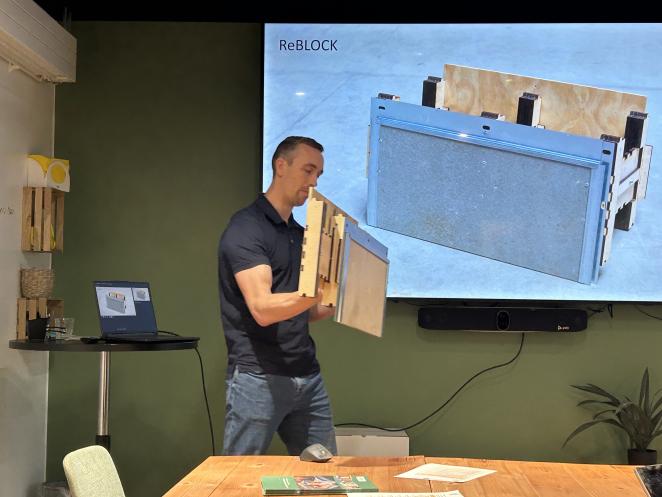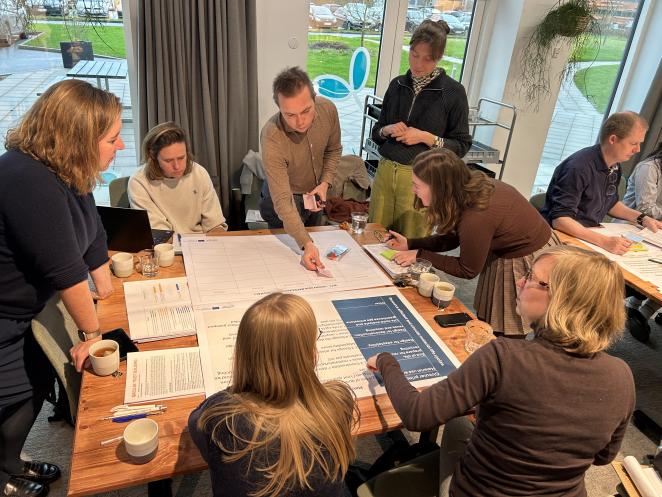On 12th November 2025, CTB partners gathered once again, this time in Vejle, Denmark, to explore further how circular thinking can reshape the way we build. Over two days, the programme offered project status updates, innovative and concrete examples and opportunites to build further on strategic tools to accelerate the transition in circular policy, practice and education.
The first day opened with a warm welcome from Flemming Kjærsgaard and Morten Damgaard Nielsen of Vejle Municipality, who both set the tone for a programme full of knowledge exchange, innovation and collaboration.

Rexcon presents innovative Danish designs inVejle
Rexcon's innovative design
Kicking off, Danish company Rexcon showcased their pioneering ReBLOCK and ReDECK systems which are modular, reusable, and low-carbon. We witnessed how design ingenuity can drastically reduce timber use while enabling fast, flexible construction.
These innovative building structures, delivered in flat packs, (think 'Lego meets Ikea') are designed for disassembly and tracked through RFID and digital twin technologies, embody the next generation of sustainable building: compact, efficient, low-impact and resilient.

Circular renovation project in Vejle
EU Taxonomy & Danish Standards
From there, discussions moved to the bigger European picture. SURA reconnected the group with CTB’s shared backcasting framework and the EU Taxonomy Compass—guiding tools for partners towards climate-neutral and circular building practices. Linnaeus University presented results from regional surveys and policy benchmarking. The analysis shows strong momentum for circularity but varying visions for 2030 and differing levels of organisational engagement. These findings, combined with identified barriers, enablers and recommended regional actions, form a critical foundation for the practical workshops held throughout the meeting.
A session by Danish Standards NGO zoomed out to the European level, explaining the current development of the S878 circular construction standard. Standardisation plays a strategic role in scaling circularity: it eases tendering, supports comparability, minimises legislative complexity and strengthens Europe’s ability to tackle climate challenges. For CTB stakeholders, this context helps frame pilots within emerging EU-wide expectations.

CTB workshop - exploring barriers and enablers
Future district design & digital tools
Later, architect Jakob Østergaard introduced New Rosborg, Vejle’s future-proof district built on the site of a former recycling centre—literally “recycling a recycling centre.” The district integrates climate adaptation, nature-based solutions and resilient design, offering a compelling case for policymakers and planners working on long-term circular area development.
The first day concluded with Circue CEO Thomas Fabian Delman, who presented digital tools for circular value chains, including future material banks, digital marketplaces and investor-ready frameworks. Their approach focuses on preserving existing building structures where possible—fully aligned with CTB’s objective to reduce resource consumption across the whole lifecycle.

CTB Visit to Ressource Center Vejle
Rubbish is a resource
Day 2 in Vejle focussed on circular practice and cross-regional learning. Partners visited the Ressource Center Vejle, to explore Denmark’s approach to maximum resource recovery. The DNGB Gold–certified building, constructed largely from upcycled and surplus materials, provided a clear demonstration of how waste streams can be transformed into valuable resources. From nine platforms, the group followed each stage of sorting, processing and preparing discarded materials for reuse or recycling.
Back at base, our academic partners discussed opportunities for student mobility and summer schools while Adriaan Klootwijk (Municipality of Groningen, WP4 lead) introduced Het Nieuwe Normaal - a Dutch circularity framework with potential for adoption across CTB regions. This shared methodology could support more consistent indicators, data collection and impact monitoring within CTB pilots.

Tour of Okolariet
Education & awareness
Final site visits in Vejle’s city centre included the emerging 'New Rosborg' district, its circular childcare facility and the sustainably renovated Municipal Library & Community Centre.
At Okolariet, Chief City Architect Liesbet Wolters presented how Vejle integrates climate and sustainability objectives into spatial planning. Then Pernille Kjoholt passionately told of Okolariet’s mission as a municipal NGO to inspire curiosity, raise awareness of natural values and become the region’s most accessible communicator on climate and sustainability. With its focus on people, behaviour and society, Okolariet complements the Ressource Center we visited earlier, both illustrating how education and awareness underpin behavioural change.
The Municipality of Vejle highlighted how circular construction can be advanced through shared frameworks, practical tools, coherent policy approaches and continuous exchange between regions.
A warm thank you to our Danish partners at Vejle Municipality for their excellent organisation, inspiring programme and generous hospitality. Next stop: Belgium, June 2026!
